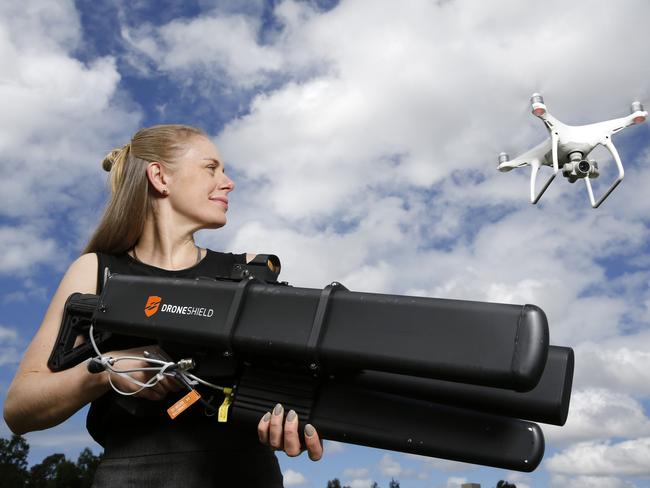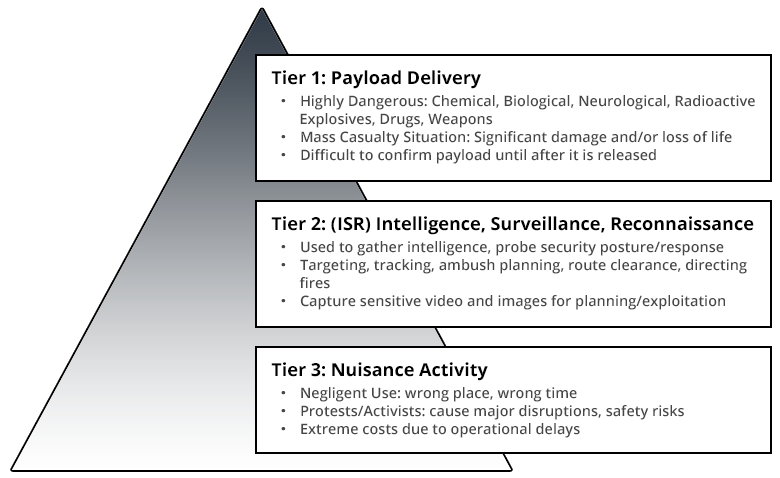Droneshield
Droneshield

Turnkey Anti-UAV solutions to augment existing system capabilities.
DroneShield provides multi-site, multi-tasking solutions. From comprehensive C-UxS solutions to maximizing the performance of currently deployed third-party sensors with AI-based sensor fusion and signal processing, we provide core capabilities for the mission. Our sensors, effectors and AI/ML can be integrated into our own Command and Control solution or fully interoperable with third-party platforms for both Government and commercial systems.


Turnkey Anti-UAV solutions to augment existing system capabilities.
DroneShield provides multi-site, multi-tasking solutions. From comprehensive C-UxS solutions to maximizing the performance of currently deployed third-party sensors with AI-based sensor fusion and signal processing, we provide core capabilities for the mission. Our sensors, effectors and AI/ML can be integrated into our own Command and Control solution or fully interoperable with third-party platforms for both Government and commercial systems.

Emerging Threat – Spread of Commercial UAVs
The rise of Unmanned Aerial Systems (“UAV”, also known as drone) has become apparent and nearly ubiquitous across industries. Today, UASs represent a more than $4.4B industry with industry prospects reaching $64B by 2025 according to ResearchAndMarkets (2019) Global Drone Service Market Analysis. Whether used for aerial mapping and photography, delivery services, disaster relief, security or performing agricultural operations, UAV technology is used in countless positive ways. There is no doubt that the UAV will stay here and become an even more prominent fixture in the airspace above us.
Increased Risk and Widespread Threat
Increasing use of drones provides increased opportunities for beneficial uses, while also providing increased opportunities for bad actors to leverage these capabilities to conduct operations.
Counterdrone (or Anti-IHA) as an industry is a young concept that has yet to emerge with any development in the last few years. In such a short period of time, the need for UAV counter-capabilities has spread to essentially every industry, just like the UAV industry itself. Military, law enforcement, prisons may be open markets for drones, but increased activity and threats are also making airports, critical infrastructure and energy producers worldwide vulnerable.
UAV is not a new threat, but a new method for transmitting existing conventional threats (such as payloads or surveillance).
Emerging Threat – Spread of Commercial UAVs
The rise of Unmanned Aerial Systems (“UAV”, also known as drone) has become apparent and nearly ubiquitous across industries. Today, UASs represent a more than $4.4B industry with industry prospects reaching $64B by 2025 according to ResearchAndMarkets (2019) Global Drone Service Market Analysis. Whether used for aerial mapping and photography, delivery services, disaster relief, security or performing agricultural operations, UAV technology is used in countless positive ways. There is no doubt that the UAV will stay here and become an even more prominent fixture in the airspace above us.
Increased Risk and Widespread Threat
Increasing use of drones provides increased opportunities for beneficial uses, while also providing increased opportunities for bad actors to leverage these capabilities to conduct operations.
Counterdrone (or Anti-IHA) as an industry is a young concept that has yet to emerge with any development in the last few years. In such a short period of time, the need for UAV counter-capabilities has spread to essentially every industry, just like the UAV industry itself. Military, law enforcement, prisons may be open markets for drones, but increased activity and threats are also making airports, critical infrastructure and energy producers worldwide vulnerable.
UAV is not a new threat, but a new method for transmitting existing conventional threats (such as payloads or surveillance).
Threat Categories
UAV threats can be classified according to the following three layers:
- Freight Delivery – Explosives, contraband and similar packages
- Intelligence Gathering – Surveillance, collection of sensitive information and images
- Disturbing Activity – Negligent use, protests or careless use

Threat Categories
UAV threats can be classified according to the following three layers:
- Freight Delivery – Explosives, contraband and similar packages
- Intelligence Gathering – Surveillance, collection of sensitive information and images
- Disturbing Activity – Negligent use, protests or careless use

Role of Anti UAV Solutions
Anti-UAV Solutions typically offer one or a combination of the following capabilities; Detect, Identify, Track and Block. The simplest way to classify counter-drone operations is the “Detect and Respond” capability.
The first step towards UAV protection is knowing when the threat arises, where it is located, or in the case of a drone swarm, where multiple threats are and ideally where the source (or pilot) is located. When tracking the UAV in real time, an appropriate action can be taken based on its location – eg. Arrest the UAS pilot.
Identifying a drone, sometimes referred to as classification, is also important. Even with a Group 1 UAS, there is a significant range from 100g or less (with very short flight times and negligible payload) to a UAS like the DJI Matrice 600 that can carry over 6kg. Determining whether the UAV is carrying a camera and/or overhead is also important and can help assess the threat. Examples of some of the larger Group 1 UAVs are shown in the figure below. Although originally designed for agricultural use or large camera loads, this UAV can be easily adapted to carry out terrorist attacks and other criminal acts.
Role of Anti UAV Solutions
Anti-UAV Solutions typically offer one or a combination of the following capabilities; Detect, Identify, Track and Block. The simplest way to classify counter-drone operations is the “Detect and Respond” capability.
The first step towards UAV protection is knowing when the threat arises, where it is located, or in the case of a drone swarm, where multiple threats are and ideally where the source (or pilot) is located. When tracking the UAV in real time, an appropriate action can be taken based on its location – eg. Arrest the UAS pilot.
Identifying a drone, sometimes referred to as classification, is also important. Even with a Group 1 UAS, there is a significant range from 100g or less (with very short flight times and negligible payload) to a UAS like the DJI Matrice 600 that can carry over 6kg. Determining whether the UAV is carrying a camera and/or overhead is also important and can help assess the threat. Examples of some of the larger Group 1 UAVs are shown in the figure below. Although originally designed for agricultural use or large camera loads, this UAV can be easily adapted to carry out terrorist attacks and other criminal acts.
Contact us
Please let us know
how we can assist
Secureway’s business philosophy is to provide the highest quality innovative solutions, total customer satisfaction, timely delivery of solutions and the best price performance available in the industry.
Our mission is to help you improve your security performance, reduce risks, make you more productive, less stressed and a little more confident.
Contact Form
Contact us
Please let us know
how we can assist
Secureway’s business philosophy is to provide the highest quality innovative solutions, total customer satisfaction, timely delivery of solutions and the best price performance available in the industry.
Our mission is to help you improve your security performance, reduce risks, make you more productive, less stressed and a little more confident.













